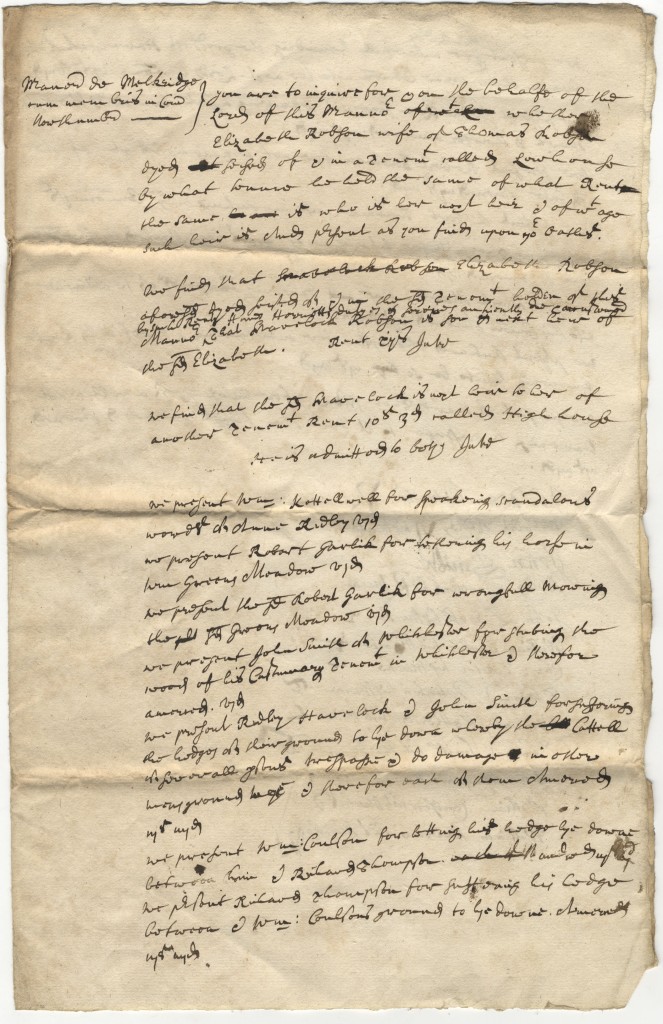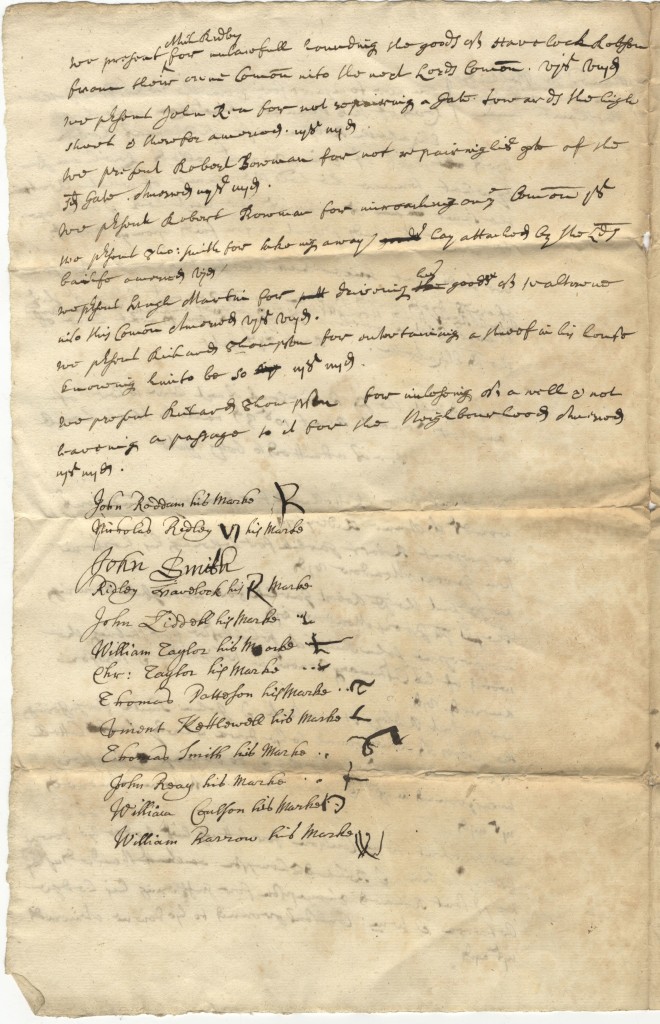The lord of the manor had the right to hold a court for his local tenants to facilitate management of the manor as a social and economic unit. From the beginning of the manorial system in the 11th century the manor courts conducted a variety of business. This was recorded on the court roll and by the 13th century it is evident that two main types of court are being recorded. The court baron, or ‘curia baronis’, was held every three weeks and handled the general business of the manor. This would involve issues relating to land tenure and use and enforce the payment of all dues and performance of services owed by the tenants to the lord. It also had other powers giving it jurisdiction over disputes between individuals and over personal actions by tenants, such as the recovery of small debts and complaints of trespass.
The court leet, or ‘curia leta’, was held every six months and inspected the working of the frankpledge, a system of mutual responsibility within a group of about ten households for the maintenance of law and order. This was often called the ‘view of frankpledge’. It also had powers to deal with offences such as common nuisances, affrays and the breaking of assize of bread and ale, (this regulated the price, weight and quantity of bread and beer sold). This court could fine and imprison offenders, in many manors in Northumberland the right went beyond imprisonment. The Barony of Langley was one of the lesser Baronies of Northumberland in which the Tindale family were enfeoffed, required to pledge service in exchange for land, by Henry I. They enjoyed an ancient liberty where they were able to try thieves in the Leet Court and then hang them on their own gallows.
The Barony of Embleton, via a succession of powerful Lords, had very extensive privileges. The incumbent Edmund Earl of Lancaster claimed, in 1292, the right to decide in his court pleas similar to those tried before the sheriff. He had a prison at Embleton and gallows at Newton, Embleton, Dunstan and Craster.
Woodhorn also seems to have had a licence for gallows in 1294, as well as Ovingham where in 1294 the Umfraville lordship claimed the right to pit and gallows, tumbrel, pillory and toll. Tynemouth also had the right to prison, gallows, tumbrel, and pillory and Bewick near Tynemouth a tumbrel and gallows.
Other types of court, which were held less frequently within the manor, included the court of survey and recognition, the court of pannage, the court of pie powder and the woodmote or forest court.
The business of the court was submitted via the presentments; this was done by the jury who were required to state or present the various matters which were dealt with by the court. The actual procedure for making presentments is not entirely clear and it is possible they were prepared several days in advance of the court session. The enclosed image is a presentment from the manor of Melkridge in Northumberland, dating from 1700, it gives a flavour of the type of court business being dealt with by the court baron.

[click to enlarge]
The jury are to enquire for and on behalf of the lord of the manor whether:
- Elizabeth Robson wife of Thomas Robson died forfeit of and in a tenement called Lowhouse and to establish who and how old the heir is.
- we present William Kettlewell for speaking scandalous words to Anne Ridley. vi d
- we present Robert Garlick for tethering his horse in William Greens meadow. vi d
- we present John Smith of Whitchester for steeling [?] the wood of his customary tenants in Whitchester and is therefore amerced (fined) vi d
- we present Ridley Haverlock and John Smith for suffering the hedges of their ground to lie down whereby the cattle can damage other men’s grounds. iii s iiii d

[click to enlarge]
- we present John Rea for not repairing a gate towards the high shoot and is therefore amerced. iiis iiiid
- we present Thomas Smith for taking away hay. vi d
- we present Richard Thompson for entertaining a thief in his house and knowing him to be so. iiis iiiid
- we present Richard Thompson for interfering with a well and not having a passage to it for the neighbourhood amerced. iiis iiiid
The presentment is signed by the jurors, note with the exception of John Smith, who can write his own name, most make their mark which in themselves are quite interesting as they have obviously been designed to be as unique as possible. A number of the jurors appear to be related to those on the presentment, or in the case of Ridley Havelock, seem to appear themselves.

i want to know if the lord of the manor of Bulbeck, still exists, and being the last silvertop, is my mother Angela Silvertop, subsecuently , the lord,….